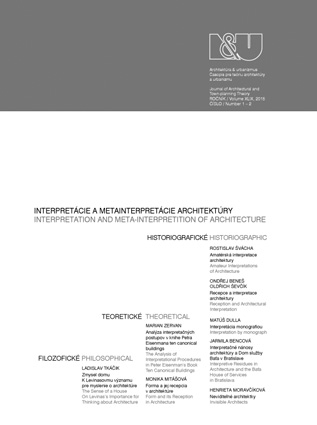AMATÉRSKÁ INTERPRETACE ARCHITEKTURY. Solitéry a sídliště v českém denním tisku, 1868 – 1989
AMATEUR INTERPRETATIONS OF ARCHITECTURE. Individual Structures and Housing Estates in the Czech Daily Press, 1868 – 1989
Author(s): Rostislav ŠváchaPublished by: Historický ústav SAV, v. v. i.
Keywords: amateur interpretation; local daily press; inter-war and post-war modernism; communism regime; mass-housing; public building; Kutná Hora; Olomouc; Liberec
Summary/Abstract: In the present article, the author presents a summarisation of the results of his study of the Czech daily press across a time period of 120 years. The scope of the reading is not limited to the papers issued in important metropolises, such as Prague or Brno, but also to newspapers from rural areas. The material is approached in terms of a news medium that has always striven to formulate as well as to reflect public opinion; in short, a phenomenon of which architectural historians have so far had little information. Hence, what is of greatest interest to the author of this article are the published opinions of lay or amateur observers, primarily journalists in rural areas. From 1868 up to around 1950, the rural Czech press devoted surprisingly extensive attention to architecture. One explanation could be that new buildings, mainly large public structures, gave the Czech-reading public a sense of civic self-confidence. New buildings were adorned with such journalistic clichés as “ornaments of the town” or buildings of “dignity”. At the same time, journalists were able to recognise individual styles, and up until the 1920s enjoyed comparing new construction to historic palaces or cathedrals. Moreover, from the period after 1900 a significant and positive value for journalists came to be “modernity”. Still, very few writers took much notice of the achievements of the architect in these buildings, and even a knowledge of the important personalities of the architecture scene was rare. A specific feature of the rural Czech press, visible from around the start of the 20th century, was a definite aversion towards Prague: the metropolis of the Czech lands seemed, in the eyes of small-town journalists, excessively cosmopolitan, superficial and self-centred. Increasingly, the model taken in the rural press tended to be the East Bohemian town of Hradec Králové and its unique construction policy. During the teens and twenties, yet another aspect of a new building’s value appeared, this being its respect for its surroundings and hence towards the regulations of heritage protection. The opposite – attacks against historic preservation – can only be encountered in the daily press after around 1930, and these exclusively in the newspapers in the town of Zlín directly owned by the Baťa corporation. Another area to which the author devotes particular attention consists of the daily papers published in the 1960 – 1989 period in the towns of Kutná Hora, Olomouc and Liberec. During this period, with the Communist regime firmly in power in Czechoslovakia, the standard approach to housing construction consisted of production of large-scale housing estates from pre-fabricated concrete panels. Understandably, the daily press in this era had a far different character than in the previous years of democratic freedoms. The contents of the state-approved newspapers were strongly determined by the needs of a centrally planned economy. As a result, newspapers divided their ..
Journal: Architektúra & Urbanizmus
- Issue Year: 49/2015
- Issue No: 1-2
- Page Range: 6 - 25
- Page Count: 20

